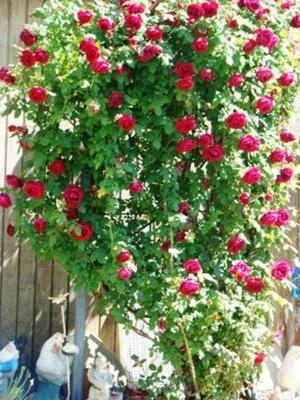Climbing roses, numbering dozens of different varieties, are becoming increasingly popular. Before you plant this flowering plant, you need to learn in detail about its agricultural technology.
These roses are bred by crossing roses of multi-flowered and climbing forms of various garden groups. Shrub is used to decorate arches, walls, pergolas, arbors, to create weeping standard forms. Climbing roses are preferable to grow in areas where there is a relatively mild climate and there is no need to cover them for the winter. In the northern latitudes, they will freeze out every winter, so they should be carefully covered in autumn. In more severe climatic conditions, it is difficult to cultivate them on a large scale, since in winter their annual shoots freeze to the soil.

This type of roses is divided into several groups. The first group is called "real climbing roses." It includes plants with flexible, long creeping shoots that need strong support. The ancestor of these plants are multi-flowered roses, the homeland of which are China, Japan, Korea. These roses are characterized by rapid growth of shoots, which can grow up to 3-4 m in length per season. Their flowers are simple, double and densely double, with a diameter of 2-5 cm. They are collected in large inflorescences and come in different colors. The flowers have a faint aroma. Plants best tolerate wintering under light shelter.
Large-flowered roses were bred by crossing climbing roses with floribunda and hybrid tea. They have hard shoots that grow up to 3 m. These roses bloom in large flowers, having a diameter of up to 10 cm, collected in small inflorescences.
Cordes' climbing roses were bred by crossing Rugosa and Vihura roses with different varieties of different garden groups. Their shoots grow up to 2 m in length. The flowers are very large, double and non-double, with and without smell, collected from small inflorescences. These roses are winter-hardy, bloom until the first frost, and are resistant to disease.
Climings were obtained as a result of mutations in the bush forms of buds (tea-hybrid, tea, polyanthus, hailflora, floribunda, miniature).
Climbing roses, the care of which is reduced to proper planting, pruning, watering and fertilizing, should not be planted close to each other, since in winter they must be laid on the ground and insulated. These shrubs do not like stagnation of water, prefer fertile loamy soils. The best fertilizer for climbing roses is rotted cow dung.
Pits with a size of 50x50 cm are prepared for planting. Mix fertile soil, a humus bucket, a bucket of sand and 3 tbsp. tablespoons of superphosphate. All mix thoroughly, forming a small hill at the bottom of the pit. It is best to plant seedlings in early spring until the buds are full. Stems of seedlings are cut to 30 cm (5-6 buds) and long roots are cut. Seedlings are disinfected in a weak solution of copper sulfate, and the roots are dipped in liquid clay. The sapling is put on a hill, the roots are evenly distributed and covered with prepared soil with humus, they compact the ground and watered abundantly.

In summer, the bushes are watered, regularly fed, the soil is loosened and weed. In September, pruning of unripened weak branches is carried out, in October-November they spud the earth, and shoots are removed from the support and laid on the ground. At the first signs of cooling, the shoots are covered with spruce pine or spruce and covered with roofing material. The fallen snow is poured on a hill for shelter.
Climbing roses, which were cared for properly, usually normally winter under good shelter. After the snow melts, the shelter is removed in the late afternoon (to prevent sunburn). Shoots need to be shaded for several days. After they get stronger, they are tied to supports. The frozen tips of the branches are cut to a living kidney.